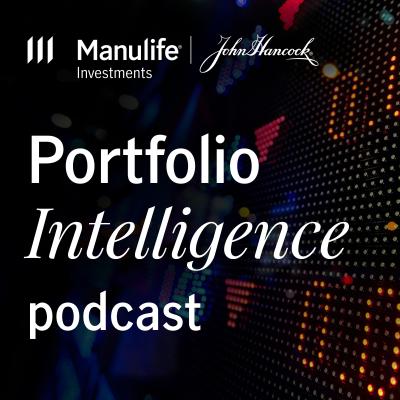
Portfolio Intelligence Podcast
engelsk
Business
Prøv gratis i 60 dager
99 kr / Måned etter prøveperioden.Avslutt når som helst.
- 20 timer lydbøker i måneden
- Eksklusive podkaster
- Gratis podkaster
Les mer Portfolio Intelligence Podcast
Portfolio Intelligence Podcast with John Bryson, head of investment consulting at Manulife John Hancock Investment Management, features interviews with asset allocation experts, portfolio construction specialists, and investment veterans from across Manulife John Hancock’s multimanager network. The dynamic discussion explores ideas advisors can use today to build their business while helping their clients pursue better investment outcomes.
Alle episoder
106 EpisoderThe role of alternative investments in modern portfolios
As the investment landscape continues to evolve, alternative investments are playing a larger role in portfolio construction. In this episode, host John Bryson talks with Pattie about the factors driving increased interest in this segment. Pattie shares insight into the development of new product structures, advances in technology, and the expanding access to private markets. She also addresses how the industry is responding to investor demand through innovation. 1 What are alternative investments? Pattie: Alternative investments are nontraditional assets outside of stocks and bonds, such as private equity, private credit, hedge funds, and real assets. They’re typically less liquid, more complex and are structured to enhance risk/return profiles. They generally provide diversification and increased income. These differ from liquid alternatives, such as long/short equity, market neutral, managed futures, and more derivative-related strategies. 2 What investor needs do alternative investments address? Pattie: Alternative investments are designed to meet investor needs and market gaps that traditional stocks and bonds may not. They provide diversification, which helps reduce portfolio concentration risk, as well as inflation protection. They also offer higher return potential through access to unique private market opportunities. Lastly, the illiquidity premium is a key feature, which is the price paid for additional returns in exchange for locking up capital for longer. 3 What’s the future of alternative investment product development? Pattie: In one word: democratization. We’ll see increased retail access to private markets, technology-driven distribution, tokenization, blockchain for settlement and customization. We’ll also see the emergence of alternative model portfolios that blend private and public assets. The industry is also focusing on innovations in liquidity and evolving fee structures.
Focusing on income and quality: portfolio positioning for 2026
2025 was a year unlike any other, with politics and sentiment driving markets more than fundamentals. In this episode, host John Bryson welcomes Matt and Emily to share their views on what shaped the year and how they’re thinking about portfolio positioning for 2026. Matt and Emily discuss why they’re taking a “drafting the market” approach, i.e., remaining fully invested, with a focus on managing risk. They explore the importance of targeting income and diversification, share their outlook on interest rates and sector dynamics, and provide practical ideas for building resilient portfolios in the year ahead. 1 Which sectors and trends stood out in 2025, and what do you expect for 2026? Emily: Market leadership broadened in 2025. Tech and communication services stayed in the lead, but industrials, financials, and healthcare also saw strong returns. Momentum was the top-performing factor. Heading into 2026, we’re looking to redeploy assets into high-quality stocks and bonds, especially as yields remain attractive. We think it’s a good time to move some cash sitting in money market funds into a diversified mix of high-quality bonds and stocks. 2 What are the top themes investors should focus on as they position portfolios for 2026? Matt: The first theme is income. After years of strong equity returns, it’s getting harder to sustain those gains. There are a lot of income opportunities, with the U.S. bond market providing attractive yields. As interest rates fall, we think investors shouldn't wait too long to allocate capital to lock in these yields. Additionally, investors can look for ways to boost return potential outside U.S. tech—consider mid and small caps. With international stocks looking expensive, we’re focused on finding areas with good quality earnings growth, such as industrials and healthcare. But above all, income remains our top focus for 2026.
What you need to know about Medicare planning
Medicare is a cornerstone of retirement planning, but its complexity can leave many retirees feeling overwhelmed. In this episode, host John Bryson, head of investment consulting, investment data analytics, and education savings at Manulife John Hancock Investments, welcomes Danielle to break down the Medicare essentials you need to know for 2026 and beyond. Danielle, author of the book 10 Costly Medicare Mistakes You Can’t Afford to Make, discusses the latest expected changes to Medicare. She emphasizes the importance of early research and understanding the difference between supplemental plans, such as Medicare Advantage plans and Medicare Supplement Insurance (Medigap). She also offers strategies to help avoid higher Income-Related Monthly Adjustment Amount (IRMAA) surcharges. Here’s a snippet from the conversation: 1 What changes are expected to Medicare in 2026? Danielle: While we don’t have some Medicare figures due to the government shutdown, we can expect Part B premiums to increase a bit. Projections suggest they could rise to $206 next year. Another major change stems from the Inflation Reduction Act of 2022, which led several carriers to exit the Part D market. As a result, about 2 million people are likely to lose their Medicare Advantage plans. If you’ve received a notice that your plan is exiting the market, it’s important to shop for a new plan promptly to ensure you have coverage in place for January 1. 2 What’s IRMAA and how does it affect Medicare costs? Danielle: IRMAA is a surcharge on Medicare Part B and Part D, based on your income. While the base rate in 2025 is $185, an IRMAA surcharge will increase that amount. As a result, Part B premiums for people in really high-income brackets can increase to over $600 per month. So, decisions you make at ages 63 and 64 can affect your Medicare premiums at 65 and 66. It’s wise to work with your financial advisor to plan ahead to explore spreading out income or avoiding large distributions that may help prevent higher premiums later.
What’s driving the renewed focus on municipal bonds
After a year marked by early uncertainty and underperformance, the municipal bond market has rallied, offering investors attractive yields and renewed opportunity as 2025 draws to a close. In this episode, host John P. Bryson welcomes Adam for a timely discussion on what’s driving performance in the municipal bond market. Adam shares his perspective on how supply dynamics, investor flows, and sector trends are shaping the market. He also discusses why entry points matter and how active management can add value in today’s environment. Here’s a sneak peek into the conversation: 1. Why should investors have tax-free municipal bonds in their portfolio? Adam: Municipal bonds work well for investors who are looking for tax-free income. Adding stability to your portfolio using municipal bonds helps offset the volatility of equity holdings. Especially when it may seem like we’re heading toward a slowdown, these instruments tend to perform slightly better than other fixed-income instruments. Municipal bonds help provide a long-term income stream for investors. 2. What have been the major developments in the municipal bond market in 2025? Adam: We started the year with weak performance, with municipal bonds underperforming corporates and Treasuries. There was an excess supply, over and above what we saw in 2024. This was driven by delayed infrastructure projects, which finally got funded, and costs went up. In the past two to three months, flows have improved, and returns are looking solid. Supply and demand have lined up. We expect solid returns in November and December, with good flows and lower supply offering support. 3. What are the biggest opportunities in the municipal bond market today? Adam: The municipal bond market is generally offering attractive yield levels currently. We like the intermediate to long space because the curve is steep and income is high, but we’re avoid going too long due to volatility. Credit spreads within the municipal bond market have widened, so there’s room for tightening. Lastly, we also see value in bonds subject to Alternative Minimum Tax, low-coupon bonds, and sectors like airports, which tend to issue at wider spreads and have strong fundamentals.
Taking stock: mixed economic signals, Fed expectations
As the economic landscape grows more complex, investors and advisors are facing new questions about growth, inflation, and what the U.S. Federal Reserve (Fed) may do next. In this episode, host John P. Bryson is joined by Matt and Emily, who discuss the strength of the ongoing market rally, recent volatility in the banking sector, the bond market, and rate-cut expectations. They emphasize thoughtful allocation, diversification, and a focus on quality as advisors position portfolios in a momentum-driven environment. Below are a few highlights from the episode: 1 How is U.S. economic data shaping up currently? Emily: Economic data is complicated right now. The latest small business survey by the National Federation of Independent Business showed a deterioration in sentiment. Manufacturing data is split, the Fed showed mixed messages, and job openings are decelerating. It's difficult to get a read right now given the lack of economic data due to the government shutdown. Overall, the U.S. economy is continuing to see a slow deceleration. 2 What is the bond market telling us about possible Fed rate cuts? Emily: Credit markets are stable, with high-yield spreads below 3.0%, suggesting no broad stress. The two-year Treasury yield, which has broken below 3.5%, indicates the Fed may need to cut rates more than previously expected. Inflation is also likely to slow more than official data suggests. Labor market softness and real-time housing data showing falling prices are leading us to expect the Fed to cut a bit more, we think potentially four or five cuts into 2026. 3 What are your conversations with advisors and investors focused on right now? Matt: While the recent rally has been remarkable, the question is if it’s sustainable. Our focus is on how to continue allocating capital for appreciation for clients, but in a thoughtful way, which is why we’re discussing diversification. We’ve talked about alternatives like infrastructure-related equities and multi-alternative strategies, as well as mid-cap equities to reduce concentration risk in large-cap U.S. stocks. On the bond side, you can still get good income for clients where you can liability match and use this income for spending needs over the coming years—so it makes sense to take advantage while it lasts.
Velg abonnementet ditt
Premium
20 timer lydbøker
Eksklusive podkaster
Gratis podkaster
Avslutt når som helst
Prøv gratis i 60 dager
Deretter 99 kr / month
Premium Plus
100 timer lydbøker
Eksklusive podkaster
Gratis podkaster
Avslutt når som helst
Prøv gratis i 60 dager
Deretter 169 kr / month
Prøv gratis i 60 dager. 99 kr / Måned etter prøveperioden. Avslutt når som helst.

































